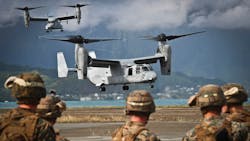L3Harris to provide SIRFC airborne electronic warfare (EW) systems for Special Operations aircraft
MacDILL AIR FORCE BASE, Fla. – Airborne electronic warfare (EW) experts at L3Harris Technologies Inc. will provide AN/ALQ-211 Suite Of Integrated Radio Frequency Countermeasures (SIRFC) equipment for U.S. Special Operations Command aircraft under terms of a $48.7 million order announced Tuesday.
Officials of the U.S. Special Operations Command at MacDill Air Force Base, Fla., are asking the L3Harris segment in Clifton, N.J., to provide SIRFC components and services for Special Operations Command.
The ALQ-211, a family of electronic self-protection systems, includes the SIRFC, which protects U.S. Special Forces helicopter and tiltrotor aircraft from sophisticated enemy radio frequency (RF) threats. Tiltrotor aircraft take off and land like helicopters, and fly like fixed-wing turboprop aircraft.
The ALQ-211 detects, denies, disrupts, degrades, and evades lethal threats and provides situational awareness for enemy threats involved with RF, infrared, and laser weapons and sensors.
When the aircrew encounters a threat emission, the ALQ-211 determines how far away it is from the mission aircraft. If the aircraft is in lethal range of a radar-, infrared-, or laser-guided missile, the ALQ-211 can break missile lock through RF and electro-optical countermeasures by cueing chaff and flares.
As the aircraft’s survivability suite controller, the ALQ-211 coordinates the response for laser and infrared threats. The system is integrated into the CV-22 Osprey Special Operations aircraft. It also is fitted to the Norwegian NH 90 multi-mission helicopter, as well as F-16 fighters for Chile, Poland, Pakistan, Turkey, and Oman.
The ALQ-211 works in densely populated hostile environments with mobile air defenses in all weather conditions, during the day, and at night. It is effective against threats hiding in terrain, and that employ adaptive tactics, L3Harris officials say.
Monday's order increases the maximum of Special Operations Command's original ALQ-211 order from $190 million to $290 million. L3Harris will do the work in Clifton, N.J., and should be finished by July 2019.
For more information contact L3Harris Electronic Systems online at www.l3harris.com, or U.S. Special Operations Command at www.socom.mil.
About the Author
John Keller
Editor-in-Chief
John Keller is the Editor-in-Chief, Military & Aerospace Electronics Magazine--provides extensive coverage and analysis of enabling electronics and optoelectronic technologies in military, space and commercial aviation applications. John has been a member of the Military & Aerospace Electronics staff since 1989 and chief editor since 1995.
